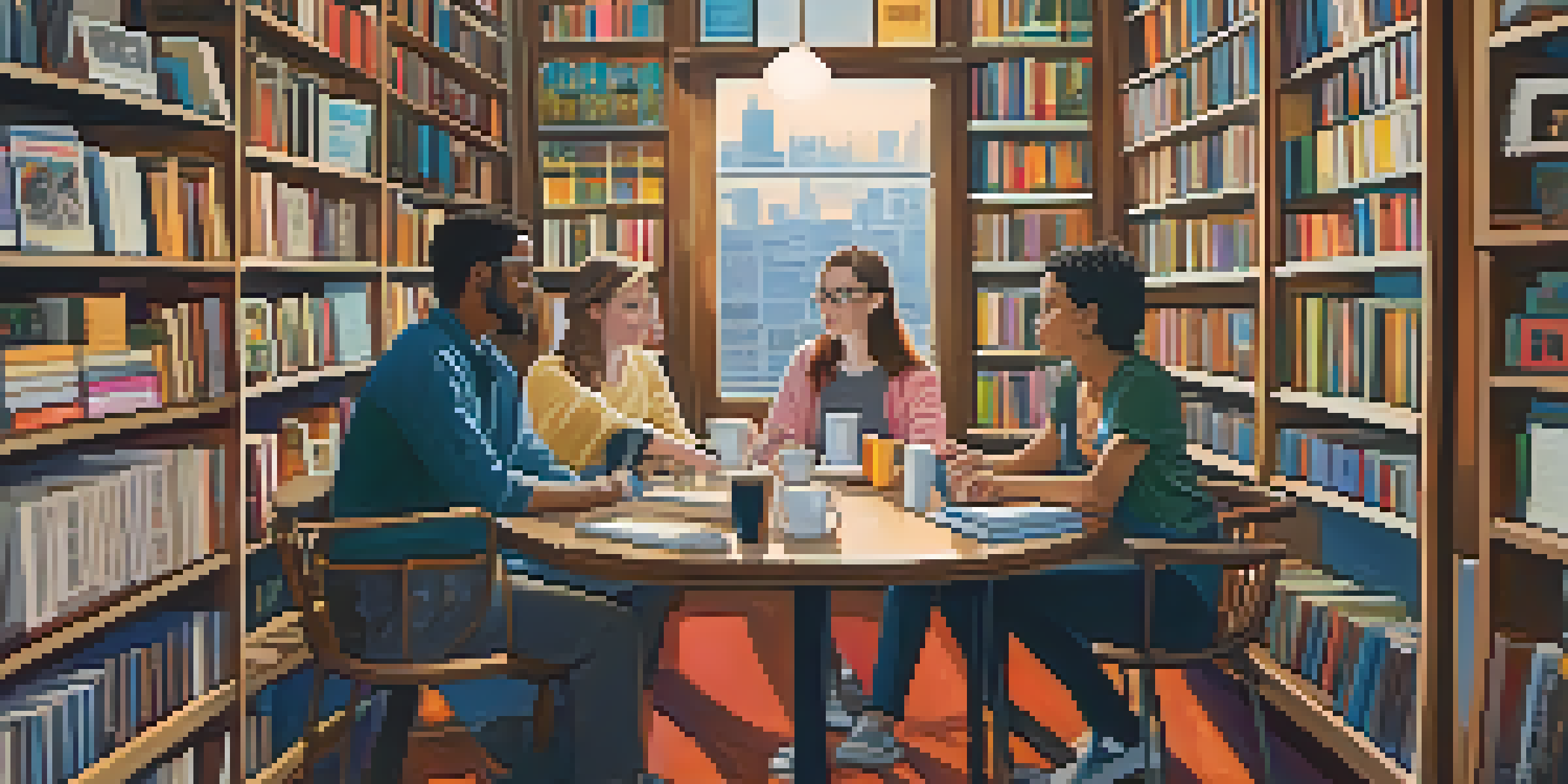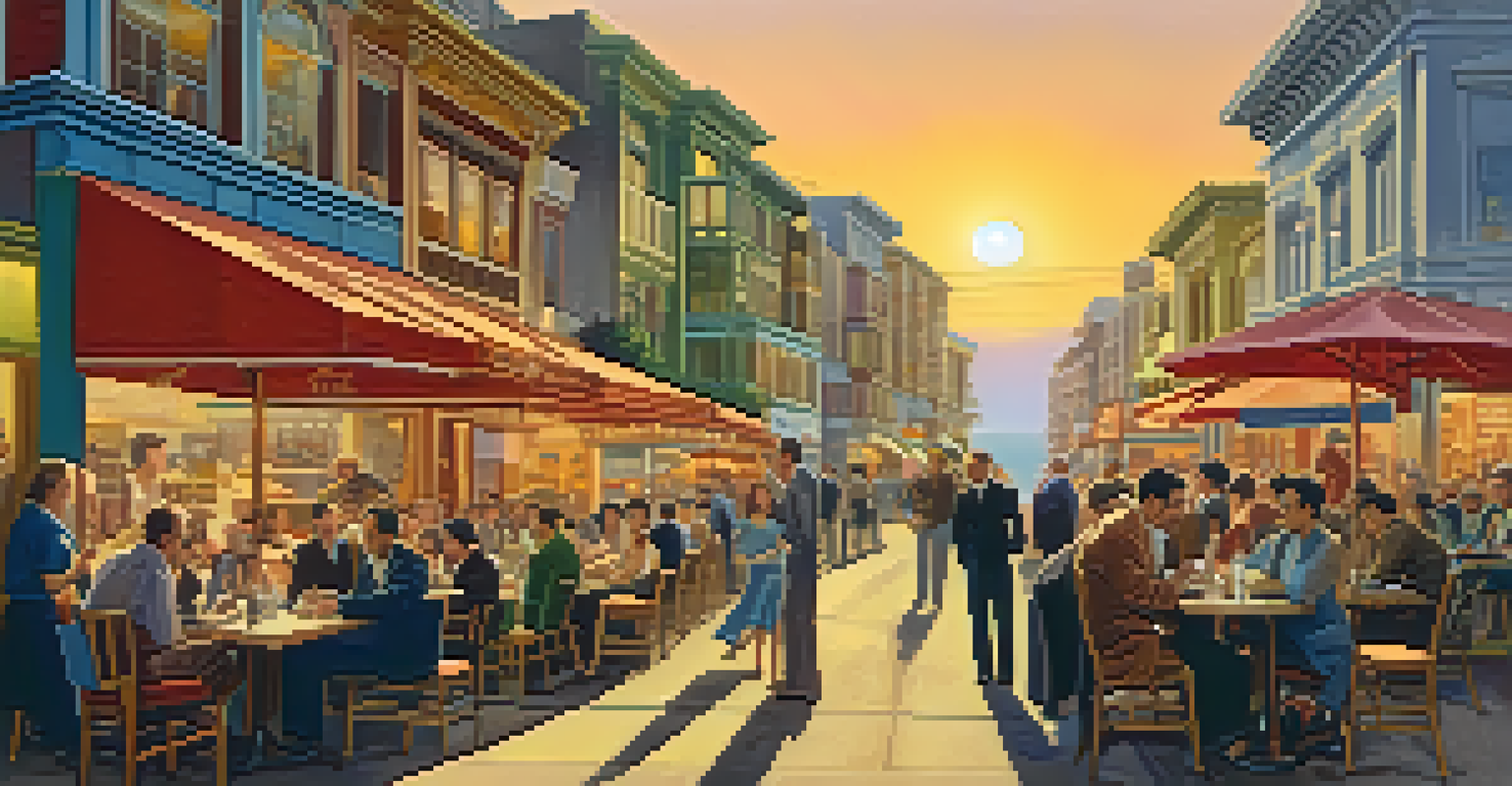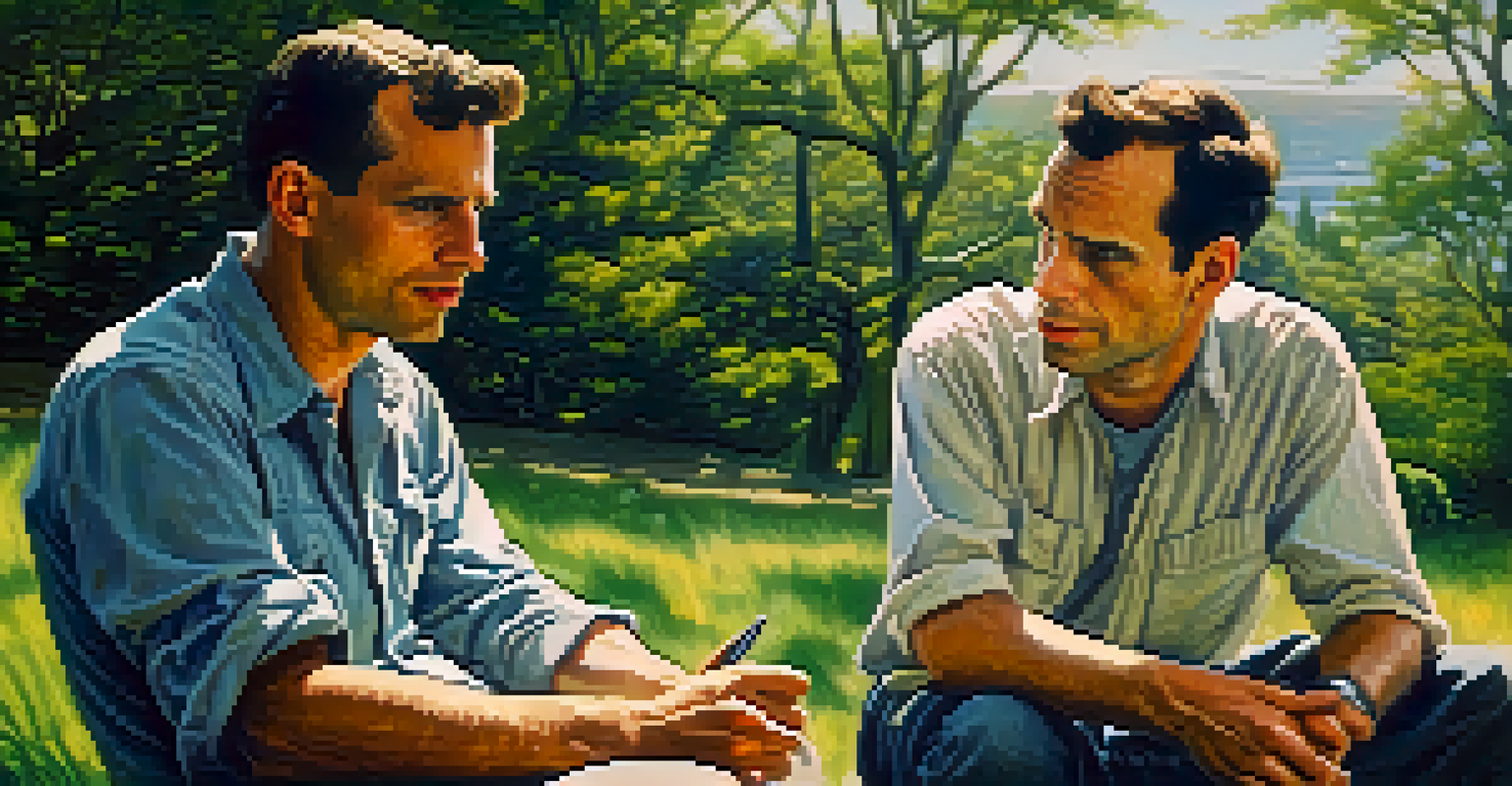San Francisco: A Hub for the Beat Generation and Its Legacy

The Birth of the Beat Generation in San Francisco
The Beat Generation, a literary and cultural movement, found its roots in the vibrant streets of San Francisco during the 1950s. This city, with its bohemian spirit and open-mindedness, became a sanctuary for writers, poets, and artists seeking freedom of expression. Figures like Jack Kerouac and Allen Ginsberg were drawn to the city's allure, finding inspiration in its cafes, parks, and unique communities.
The only people for me are the mad ones, the ones who are mad to live, mad to talk, mad to be saved.
San Francisco's atmosphere fostered creativity and encouraged unconventional ideas, making it the perfect backdrop for the Beats. The famous City Lights Bookstore, founded by Lawrence Ferlinghetti, became a cultural oasis where young writers could gather, share their works, and challenge societal norms. This hub of literary activity not only nurtured the Beats but also helped to redefine the American literary landscape.
As the Beats began to publish their works, they captured the essence of a generation that sought authenticity and rebellion against the conformist ideals of the time. Their influence spread beyond the city, igniting a movement that resonated with youth across the nation, creating a legacy that would endure for decades.
Key Figures: Icons of the Beat Movement
The Beat Generation was characterized by a handful of iconic figures whose works and lives became synonymous with the movement. Jack Kerouac, often regarded as the 'father' of the Beats, penned the groundbreaking novel 'On the Road,' which encapsulated the restless spirit and wanderlust of the era. His spontaneous prose and vivid storytelling inspired countless readers to seek their own paths.

Allen Ginsberg, another central figure, is best known for his poem 'Howl,' a powerful critique of modern society that challenged the status quo. Ginsberg's fearless exploration of taboo subjects mirrored the Beats' commitment to authenticity and self-expression. His readings in cafes and public spaces galvanized a sense of community among fellow artists and intellectuals.
Beat Generation's San Francisco Roots
The vibrant streets of San Francisco served as a sanctuary for the Beat Generation, fostering creativity and freedom of expression among writers and artists.
Lastly, poets like Lawrence Ferlinghetti and Gregory Corso added their voices to the chorus of the Beat Generation, each contributing unique perspectives on love, society, and the human experience. Together, these figures forged a literary legacy that would influence future generations of writers and artists around the globe.
San Francisco's Iconic Locations in Beat History
San Francisco is dotted with locations that played pivotal roles in the Beat Generation's narrative. One of the most famous sites is City Lights Bookstore, which not only served as a meeting place for writers but also published several key Beat texts. Walking through its aisles today, you can still feel the echoes of passionate discussions and revolutionary ideas that once filled the air.
Follow your inner moonlight; don’t hide the madness.
Another significant location is the former Bohemian Grove, where many artists gathered to share their works and experiences. The surrounding natural beauty provided a perfect retreat for creative minds seeking inspiration away from the hustle of city life. The Grove epitomized the Beats' connection to nature and the unconventional lifestyle they embraced.
Additionally, North Beach, San Francisco's Little Italy, was a hub for the Beat community. Cafes like the legendary Vesuvio offered a vibrant atmosphere where writers could mingle and share their thoughts over coffee and cigarettes, fostering a sense of belonging among the artists of the time.
The Beats and the Counterculture Movement
The Beat Generation laid the groundwork for the counterculture movement of the 1960s, influencing a wide array of social and political changes. Their rejection of materialism and advocacy for peace resonated with the youth of the time, who were eager to challenge authority and seek new forms of expression. The Beats' emphasis on personal freedom and exploration sparked a desire for change that extended beyond literature into music, art, and lifestyle.
As the counterculture movement gained momentum, the Beats became cultural icons, embodying the spirit of rebellion and liberation. Events like the Summer of Love in 1967 drew heavily from Beat ideals, as young people flocked to San Francisco in search of community, love, and artistic expression. The city became a symbol of a new way of living, one that valued creativity and self-discovery.
Influential Figures of the Beats
Key figures like Jack Kerouac and Allen Ginsberg became icons of the Beat movement, whose works challenged societal norms and inspired future generations.
The Beats' influence can still be felt today, as their ideals continue to inspire contemporary movements advocating for social justice and personal freedom. They paved the way for future generations to explore their identities and challenge societal norms, leaving an indelible mark on American culture.
Literary Contributions of the Beat Generation
The literary contributions of the Beat Generation are vast and varied, encompassing poetry, novels, essays, and more. Their works often challenged traditional literary forms, embracing spontaneity and free verse as a means of expression. This innovative approach not only pushed the boundaries of literature but also opened the door for future writers to explore new styles and themes.
One of the most significant aspects of Beat literature is its focus on personal experience and authenticity. The Beats wrote candidly about their lives, relationships, and struggles, inviting readers into their world. This raw and honest storytelling resonated with many, fostering a sense of connection and understanding that transcended generations.
Moreover, the Beats explored themes of spirituality and existentialism, delving into the quest for meaning in a complex world. Their writings often reflected a search for enlightenment and a desire to break free from societal constraints, paving the way for deeper discussions about philosophy and the human experience in literature.
The Beats and Their Impact on Modern Culture
The legacy of the Beat Generation extends far beyond their literary contributions; they have left a lasting impact on modern culture. Their emphasis on individuality and self-expression has influenced various artistic movements, from the hippie culture of the '60s to contemporary art and music. The Beats encouraged people to embrace their uniqueness and challenge societal expectations, a message that continues to resonate today.
In music, the Beats' spirit can be seen in the works of iconic artists such as Bob Dylan and Jim Morrison, who drew inspiration from their rebellious attitudes and poetic lyrics. The fusion of literature and music during this time created a powerful cultural synergy that shaped the sound of a generation and continues to inspire musicians today.
Cultural Legacy of the Beats
The Beat Generation laid the groundwork for the counterculture movement and continues to influence modern culture through their emphasis on individuality and self-expression.
Furthermore, the Beats' exploration of spirituality and alternative lifestyles has inspired modern wellness movements that prioritize mindfulness and personal growth. By challenging conventional norms, the Beats opened up a dialogue about the importance of self-discovery and living authentically, encouraging individuals to seek their own paths in life.
Visiting San Francisco: A Beat Pilgrimage
For those intrigued by the Beat Generation, a visit to San Francisco offers a unique opportunity to walk in the footsteps of these literary pioneers. Start at City Lights Bookstore, where you can browse a collection of Beat literature and attend readings that celebrate their legacy. The bookstore serves as a reminder of the vibrant community that once thrived within its walls.
Next, take a stroll through North Beach, where the spirit of the Beats still lingers in the air. Stop by Vesuvio Cafe, a favorite haunt of Beat writers, and indulge in a cup of coffee while soaking in the artistic atmosphere. The neighborhood is filled with murals and tributes to the Beats, allowing visitors to connect with the history and culture of the era.

Lastly, don't miss a visit to the Beat Museum, which showcases artifacts, photographs, and exhibits dedicated to the movement. This intimate space offers a deeper understanding of the Beats' influence and contributions, making it an essential stop for anyone looking to appreciate their enduring legacy in San Francisco.